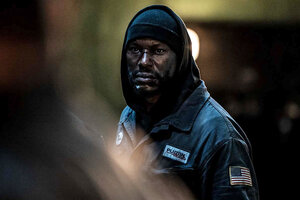‘1992’ says something important about race in America – and Tyrese Gibson

Actor Tyrese Gibson stars in “1992.” The film is set at the time when four Los Angeles police officers were acquitted of assault in the brutal beating of motorist Rodney King.
Courtesy of Lionsgate
A couple of Saturdays ago, I found myself catching a night football game starring my beloved Florida A&M Rattlers. (Yes, I’m an alum.) Unexpectedly, a familiar face popped up on-screen: singer and actor Tyrese Gibson, a mainstay of the “Fast & Furious” franchise.
“What is he doing here?” I asked myself. The jumbotron quickly answered. Mr. Gibson was on hand to promote his latest film, “1992.” So I went to see it.
The film is a lot of things. It’s the legendary Ray Liotta’s last movie. It’s a crime-suspense thriller about a heist gone wrong. It’s an examination of fathers and sons, juxtaposing Mr. Gibson’s and Mr. Liotta’s roles as imperfect parents to adolescent and adult males. But it is also intentional about the actual event that defines the film: On April 29, 1992, a jury acquitted four Los Angeles police officers of assault in the brutal beating of Rodney King, a Black man. Violence followed.
Why We Wrote This
The new film “1992” is a reminder of America’s cycles of race conflict and rebellion. Actor Tyrese Gibson stands out as a portrait of hope.
That intrigued me from the outset. The events around the King verdict made 1992 an important year for the “language of the unheard.” It brought attention to the plight of those too often overlooked or ignored. How would the film address those elements of history?
1992 and 2020
At first, my reaction was one of association. The film “1992,” of course, reminded me of 2020. It reminded me of the furor over George Floyd’s murder and how, for a moment, that inspired a nation to do better. Mr. Floyd’s story, along with those of Breonna Taylor and Ahmaud Arbery, challenged how the justice system deals with Black people and held it to account.
The fervor of those days is visible in the film’s depiction of outrage, confusion, and despair in a Black community wrestling with such injustice.
But in that way, the movie also is a reminder of how that national urgency has abated. It is not building off a wave of outrage. It seeks to rekindle one – or at least to reawaken the discussion.
In its high points, it even strikes a contemplative tone. In one poignant scene, Mr. Gibson’s character and his son offer insight into what it means for people to riot and cause damage in their own communities. Is an antiestablishment, “fight the power” sentiment essential? Or does it only make rebuilding harder in a community already struggling with limited resources and fractured trust?
When the historian in me watches “1992,” he sees a pattern.
Just as Mr. Floyd’s murder happened close to 30 years after the King beating and verdict, the King unrest happened three decades after the similar events in the Los Angeles neighborhood of Watts. In mid-August 1965, an argument between a Black motorist, Marquette Frye, and a white police officer escalated into nearly a week of rioting. The incident inspired leaders of the Southern Christian Leadership Conference, such as Martin Luther King Jr., to widen their gaze beyond the South.
But what happened in Watts, and then after the King verdict, and then again after the murder of Mr. Floyd? Was there unrest, including violence and rioting? Yes. But also rebellion.
Rioting and community angst is never unprovoked. Elizabeth Hinton’s beautiful book “America on Fire” looks at the untold history of police violence and Black rebellion since the 1960s, as the subtitle puts it. It states, “The history of Black rebellion across regions and decades demonstrates a fundamental reality: police violence precipitates community violence.”
Gibson’s standout performance
In “1992,” this spirit is best embodied in Mr. Gibson, who often redeems the film from its inconsistencies. In other moments, for example, Black characters are treated like fodder for a middling plot and discarded when that script falls apart.
Mr. Gibson’s performance is an extension of the press appearances he made ahead of the film. His intent to promote the stories of Black people came off as refreshingly honest. “Black men cry,” he offered during one appearance, where he talked about grief, divorce, and his mother’s passing.
I can still remember the 1994 ad in which Mr. Gibson got his start, singing the praises of Coca-Cola on a city bus. Here, he shows how much has changed, tapping into the angst of a historic time period and delivering one of his most important performances on-screen. As an actor, he has evolved, grown, matured.
I would like to think this country is capable of a similar transformation. To claim it, we must acknowledge that the events of 1992 are but part of a pattern – a greater and sadder tale. At the end of the film, a refrain from the late Donny Hathaway’s “Little Ghetto Boy” plays over the closing credits and resonates: “Everything has got to get better.”

